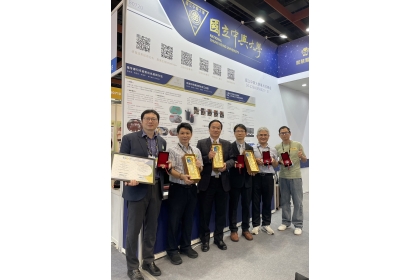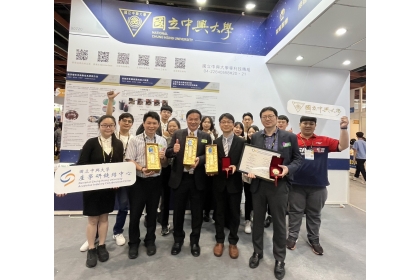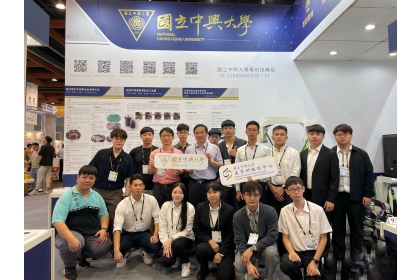NCHU Wins 3 Platinum, 2 Gold, 4 Silver, and 1 Bronze at the 2024 Taiwan Innotech Expo Invention Contest
2024-10-21
興新聞張貼者
Unit秘書室
1,741
Source: Academia-Industry Collaboration Center, National Chung Hsing University
The 2024 Taiwan Innotech Expo held its awards ceremony on October 19, with the Invention Contest, hosted by the Intellectual Property Office of the Ministry of Economic Affairs, attracting nearly 600 entries. Delegations from countries such as South Korea, Indonesia, and Thailand also participated, highlighting the high level of competition and prestige of the Platinum Award in the invention world. National Chung Hsing University (NCHU) set a new record this year by winning 3 Platinum, 2 Gold, 4 Silver, 1 Bronze, and 1 Corporate Special Award. The awarded inventions cover areas such as wireless power transfer, net-zero technology, smart manufacturing, information technology, and medical devices. Several companies are actively negotiating technology transfer and industry-academia cooperation.
Platinum Award-Winning Technologies
1. Prof. Lu Ming-Jun (Department of Environmental Engineering): " Method and equipment for recovering carbon dioxide using absorption and homogeneous crystallization technology "
Fluidized Bed Homogeneous Crystallization Technology for Capturing and Recycling CO2 from Flue Gas” involves absorbing CO2 from flue gas at normal temperature and pressure to produce homogeneous calcium carbonate crystals. This technology can reuse high-calcium brine, incineration fly ash, or basic-oxygen-furnace (BOF) slag as calcium sources. The high-quality, light calcium carbonate crystals produced can be recycled for industrial uses such as in paper, rubber, plastics, and coatings.
2. Associate Professor Li Lian-Wang (Department of Mechanical Engineering): "Mobile Multifunctional Intelligent Gait Training Device"
The mobile multifunctional intelligent gait training machine integrates a dynamic body weight support system, lower limb exoskeleton, real-time physiological monitoring, and brain-computer interface technologies to offer a comprehensive solution for rehabilitation patients. This training machine not only ensures the safety of training through physiological data monitoring but also promotes neural plasticity and the recovery of motor functions, significantly enhancing rehabilitation outcomes.
3. Prof. Zhu Yan-Wei (Graduate Institute of Biomedical Informatics): "System and Method for Predicting Water Demand in Rice Cultivation"
The patented technology "System and Method for Predicting Water Demand in Rice Cultivation," developed by Distinguished Professor Yen-Wei Chu's team from the Institute of Genomics and Bioinformatics at NCHU, has been awarded a Platinum medal. This invention collects physiological signals from crops to provide precise cultivation decisions. Applicable to mobile phones and drones, it offers easy operation and low cost. In practical field applications, it achieves 93-96% accuracy, supporting water conservation, carbon reduction, and environmental sustainability. The system has been successfully applied domestically and expanded to Indonesia, in September.
Gold Award-Winning Technologies:
1. Associate Professor Li Lian-Wang (Department of Mechanical Engineering): " Wearable Waist-Assistive Exoskeleton System
The wearable waist-assistive exoskeleton system features an innovative design that combines pneumatic muscles with safety control technology, meeting the dual requirements of lightweight construction and compliant control. It is specifically designed to prevent lower back injuries during repetitive lifting tasks. The system provides effective support for the lower back, reducing the risk of musculoskeletal injuries while enhancing work efficiency.
2. Prof. Lai Qing-Ming (Department of Electrical Engineering): " Capacitance Adjustment Device and Wireless Power Transfer Device "
The application of wireless charging systems in daily life is becoming increasingly common, such as in mobile phones and power banks, automated guided vehicles (AGVs), electric vehicles, and more. However, when misalignment occurs between the device and the coil, the efficiency and reliability significantly decrease, leading to a rapid rise in temperature and potentially causing fire hazards. To address this, Professor Ching-Ming Lai has pioneered the use of active resonant capacitor control technology domestically to stabilize the operating point of wireless charging systems, ensuring a smoother efficiency curve with maximum power transmission conditions. Verified results show that when a 200W/48V device is misaligned with the coil, the technology developed by Professor Lai allows the wireless charging system to continue outputting voltage very stably, improving efficiency by over 15%. At the Taiwan Innotech Expo, Professor Lai's technology addresses current shortcomings in wireless power transmission, promising future applications that combine high reliability with energy efficiency. The technology has already attracted interest from major international power companies seeking technical collaboration.
<>Silver Award-Winning Technologies:
1. Associate Professor Li Lian-Wang (Department of Mechanical Engineering): " Mobile Multifunctional Overground Walking Rehabilitation Device "
The mobile multifunctional intelligent gait training machine integrates a dynamic body weight support system, lower limb exoskeleton, real-time physiological monitoring, and brain-computer interface technologies to offer a comprehensive solution for rehabilitation patients. This training machine not only ensures the safety of training through physiological data monitoring but also promotes neural plasticity and the recovery of motor functions, significantly enhancing rehabilitation outcomes.
2. Associate Professor Li Lian-Wang (Department of Mechanical Engineering): " Upper Limb Rehabilitation Device "
The upper limb rehabilitation device is a home-based rehabilitation system with omnidirectional mobility, capable of providing both active and passive, as well as resistance training for upper and lower limbs on a single platform, making it suitable for all stages of recovery for hemiplegic patients. With IoT-based remote monitoring, physicians can easily track patient progress. The system also integrates virtual rehabilitation games to boost engagement, which is especially valuable during viral outbreaks, as it effectively reduces the need for patients to leave their homes.
3. Prof. Zhuang Jia-Feng (Department of Electrical Engineering): " Estimation of the severity of sleep apnea under multiple screening factors "
Obstructive sleep apnea (OSA) is associated with comorbidities such as cardiovascular diseases, memory decline, and depression, and is also one of the causes of traffic accidents. This technology uses only waist circumference, neck circumference, and blood pressure upon waking to screen for moderate to severe OSA with 80.0% sensitivity, without the need for overnight monitoring. Through this method, early intervention can be applied to improve the quality of life.
4. Associate Professor Liu Jun-Nian (Department of Electrical Engineering): " Solid-State Optical Phase Scanning Module "
The research team led by Professor Chun-Nien Liu at National Chung Hsing University has been recognized for their development of the “Solid-State Optical Phase Scanning Module.” This innovative technology integrates a reflective optical phased array (OPA) chip with an FMCW laser source, achieving high-precision, fully solid-state beam control. By eliminating traditional mechanical components, the design enhances system stability and reliability. Moreover, it is compatible with CMOS semiconductor processes, providing cost advantages and mass production potential. This technology demonstrates outstanding application value in autonomous vehicles and intelligent sensing, laying a solid foundation for Taiwan’s competitiveness in the global autonomous driving market.
Bronze Award-Winning Technology:
Prof. Lin Ming-Ze (Precision Machinery Institute): " PROCESSING APPARATUS DISPOSED ON A MANIPULATING DEVICE "
After traditional machining, burrs and surface roughness often appear, requiring manual grinding and polishing. Additionally, switching between cutting and grinding requires changing the grinding wheel, and if it is not properly tightened, it may damage the workpiece. This invention utilizes the BUFF device to automatically change the grinding wheel, simulating the consistent force applied by a craftsman, reducing the time spent on manual replacement, and increasing productivity and efficiency.
With these outstanding achievements, NCHU continues to excel in innovation, driving industry-academia collaboration and technology commercialization.
The 2024 Taiwan Innotech Expo held its awards ceremony on October 19, with the Invention Contest, hosted by the Intellectual Property Office of the Ministry of Economic Affairs, attracting nearly 600 entries. Delegations from countries such as South Korea, Indonesia, and Thailand also participated, highlighting the high level of competition and prestige of the Platinum Award in the invention world. National Chung Hsing University (NCHU) set a new record this year by winning 3 Platinum, 2 Gold, 4 Silver, 1 Bronze, and 1 Corporate Special Award. The awarded inventions cover areas such as wireless power transfer, net-zero technology, smart manufacturing, information technology, and medical devices. Several companies are actively negotiating technology transfer and industry-academia cooperation.
Platinum Award-Winning Technologies
1. Prof. Lu Ming-Jun (Department of Environmental Engineering): " Method and equipment for recovering carbon dioxide using absorption and homogeneous crystallization technology "
Fluidized Bed Homogeneous Crystallization Technology for Capturing and Recycling CO2 from Flue Gas” involves absorbing CO2 from flue gas at normal temperature and pressure to produce homogeneous calcium carbonate crystals. This technology can reuse high-calcium brine, incineration fly ash, or basic-oxygen-furnace (BOF) slag as calcium sources. The high-quality, light calcium carbonate crystals produced can be recycled for industrial uses such as in paper, rubber, plastics, and coatings.
2. Associate Professor Li Lian-Wang (Department of Mechanical Engineering): "Mobile Multifunctional Intelligent Gait Training Device"
The mobile multifunctional intelligent gait training machine integrates a dynamic body weight support system, lower limb exoskeleton, real-time physiological monitoring, and brain-computer interface technologies to offer a comprehensive solution for rehabilitation patients. This training machine not only ensures the safety of training through physiological data monitoring but also promotes neural plasticity and the recovery of motor functions, significantly enhancing rehabilitation outcomes.
3. Prof. Zhu Yan-Wei (Graduate Institute of Biomedical Informatics): "System and Method for Predicting Water Demand in Rice Cultivation"
The patented technology "System and Method for Predicting Water Demand in Rice Cultivation," developed by Distinguished Professor Yen-Wei Chu's team from the Institute of Genomics and Bioinformatics at NCHU, has been awarded a Platinum medal. This invention collects physiological signals from crops to provide precise cultivation decisions. Applicable to mobile phones and drones, it offers easy operation and low cost. In practical field applications, it achieves 93-96% accuracy, supporting water conservation, carbon reduction, and environmental sustainability. The system has been successfully applied domestically and expanded to Indonesia, in September.
Gold Award-Winning Technologies:
1. Associate Professor Li Lian-Wang (Department of Mechanical Engineering): " Wearable Waist-Assistive Exoskeleton System
The wearable waist-assistive exoskeleton system features an innovative design that combines pneumatic muscles with safety control technology, meeting the dual requirements of lightweight construction and compliant control. It is specifically designed to prevent lower back injuries during repetitive lifting tasks. The system provides effective support for the lower back, reducing the risk of musculoskeletal injuries while enhancing work efficiency.
2. Prof. Lai Qing-Ming (Department of Electrical Engineering): " Capacitance Adjustment Device and Wireless Power Transfer Device "
The application of wireless charging systems in daily life is becoming increasingly common, such as in mobile phones and power banks, automated guided vehicles (AGVs), electric vehicles, and more. However, when misalignment occurs between the device and the coil, the efficiency and reliability significantly decrease, leading to a rapid rise in temperature and potentially causing fire hazards. To address this, Professor Ching-Ming Lai has pioneered the use of active resonant capacitor control technology domestically to stabilize the operating point of wireless charging systems, ensuring a smoother efficiency curve with maximum power transmission conditions. Verified results show that when a 200W/48V device is misaligned with the coil, the technology developed by Professor Lai allows the wireless charging system to continue outputting voltage very stably, improving efficiency by over 15%. At the Taiwan Innotech Expo, Professor Lai's technology addresses current shortcomings in wireless power transmission, promising future applications that combine high reliability with energy efficiency. The technology has already attracted interest from major international power companies seeking technical collaboration.
<>Silver Award-Winning Technologies:
1. Associate Professor Li Lian-Wang (Department of Mechanical Engineering): " Mobile Multifunctional Overground Walking Rehabilitation Device "
The mobile multifunctional intelligent gait training machine integrates a dynamic body weight support system, lower limb exoskeleton, real-time physiological monitoring, and brain-computer interface technologies to offer a comprehensive solution for rehabilitation patients. This training machine not only ensures the safety of training through physiological data monitoring but also promotes neural plasticity and the recovery of motor functions, significantly enhancing rehabilitation outcomes.
2. Associate Professor Li Lian-Wang (Department of Mechanical Engineering): " Upper Limb Rehabilitation Device "
The upper limb rehabilitation device is a home-based rehabilitation system with omnidirectional mobility, capable of providing both active and passive, as well as resistance training for upper and lower limbs on a single platform, making it suitable for all stages of recovery for hemiplegic patients. With IoT-based remote monitoring, physicians can easily track patient progress. The system also integrates virtual rehabilitation games to boost engagement, which is especially valuable during viral outbreaks, as it effectively reduces the need for patients to leave their homes.
3. Prof. Zhuang Jia-Feng (Department of Electrical Engineering): " Estimation of the severity of sleep apnea under multiple screening factors "
Obstructive sleep apnea (OSA) is associated with comorbidities such as cardiovascular diseases, memory decline, and depression, and is also one of the causes of traffic accidents. This technology uses only waist circumference, neck circumference, and blood pressure upon waking to screen for moderate to severe OSA with 80.0% sensitivity, without the need for overnight monitoring. Through this method, early intervention can be applied to improve the quality of life.
4. Associate Professor Liu Jun-Nian (Department of Electrical Engineering): " Solid-State Optical Phase Scanning Module "
The research team led by Professor Chun-Nien Liu at National Chung Hsing University has been recognized for their development of the “Solid-State Optical Phase Scanning Module.” This innovative technology integrates a reflective optical phased array (OPA) chip with an FMCW laser source, achieving high-precision, fully solid-state beam control. By eliminating traditional mechanical components, the design enhances system stability and reliability. Moreover, it is compatible with CMOS semiconductor processes, providing cost advantages and mass production potential. This technology demonstrates outstanding application value in autonomous vehicles and intelligent sensing, laying a solid foundation for Taiwan’s competitiveness in the global autonomous driving market.
Bronze Award-Winning Technology:
Prof. Lin Ming-Ze (Precision Machinery Institute): " PROCESSING APPARATUS DISPOSED ON A MANIPULATING DEVICE "
After traditional machining, burrs and surface roughness often appear, requiring manual grinding and polishing. Additionally, switching between cutting and grinding requires changing the grinding wheel, and if it is not properly tightened, it may damage the workpiece. This invention utilizes the BUFF device to automatically change the grinding wheel, simulating the consistent force applied by a craftsman, reducing the time spent on manual replacement, and increasing productivity and efficiency.
With these outstanding achievements, NCHU continues to excel in innovation, driving industry-academia collaboration and technology commercialization.




